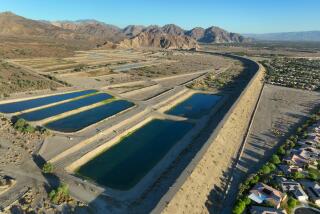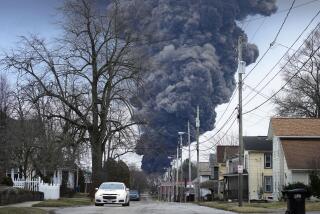Study Disagrees With EPA on Perchlorate
In a long-awaited report, a national panel of scientists wrote Monday that perchlorate, an ingredient of solid rocket fuel that has contaminated drinking water and food throughout the country, poses a public health risk at low doses but not at amounts as low as the U.S. Environmental Protection Agency had calculated.
The chemical, used primarily by the military, NASA and their contractors, has seeped into hundreds of wells in Southern California and contaminated Colorado River water used for drinking and for irrigating crops in the region.
The scientific controversy over what level of the chemical is safe for human consumption pits the Pentagon against environmentalists and drew the attention of top-level White House officials. Environmental groups Monday accused the White House and Pentagon of influencing the panel’s findings.
The National Research Council panel, led by Richard B. Johnston Jr. of the University of Colorado’s School of Medicine in Denver, concluded that perchlorate posed a health threat because it can interfere with the human thyroid gland, which controls how the brain develops in infancy.
The scientists said their recommendation of a safe daily dose “would protect the health of even the most sensitive populations”: babies born to women with a thyroid problem or iodide deficiency.
The panel did not suggest a specific limit for drinking water, but it did recommend an amount, called a reference dose, that would cause no human health effects if consumed daily in water and food. The number is meant to be used by the EPA and state health departments to calculate a standard for the amount allowable in drinking water.
The maximum daily dose of perchlorate recommended by the scientists is about 23 times higher than recently proposed by the EPA. The panel recommended 0.0007 milligrams per kilogram of body weight per day compared with EPA’s 0.00003.
It remains uncertain how stringent a standard would result from the panel’s recommendation. Several toxicologists said Monday they anticipated it would probably be in the range of 2 to 6 parts per billion. That is more than the 1 part per billion that environmentalists advocate but far less than the 200 parts per billion that industry groups have suggested.
In comparison, California has set a public health goal -- which is not yet an enforceable limit -- of 6 parts per billion. Allan Hirsch of the state Office of Environmental Health Hazard Assessment said that the scientists’ report generally supports the state’s recommendation, although “some fine-tuning” may result.
The number that the EPA ultimately uses will determine which water supplies are safe and how large cleanups by the military and aerospace companies will have to be. Those cleanups could cost billions of dollars. More than 11 million people in the United States drink water with perchlorate levels of 4 parts per billion or higher. Thirty-five states are affected.
Environmentalists’ reaction to the report varied. The Environmental Working Group, which specializes in exploring the health effects of contaminants, supported the findings.
“It is evident that there has been a lot of political pressure, so we are pleased that, in this climate, the National Academy of Sciences has come out with this recommendation,” said Bill Walker of the Environmental Working Group.
But the Natural Resources Defense Council said the panel’s findings will “threaten the health of millions of American children.” The group said the report “was likely shaped by a covert campaign by the White House, Pentagon and defense contractors to twist the science and strong-arm the academy.”
The EPA, the Pentagon and NASA had requested a report to clear up questions about the results of various academic and industry tests on humans and lab animals.
The Natural Resources Defense Council, which filed a lawsuit to obtain records from the White House, Defense Department and EPA, contends that the administration waged a “behind-the-scenes campaign” to limit the scope of the study and help select panel members favorable to industry.
The group cited a string of e-mails from the White House and Defense Department that discussed such topics as what the scientists should look at and who should be on the panel. The administration refused to disclose the messages but instead described them to the environmental group. The e-mails also suggest that Defense Department contractors and chemical companies -- including Lockheed Martin and Kerr-McGee -- weighed in on the perchlorate discussion and met with White House officials.
Bob Hopkins, a spokesman for the White House Office of Science and Technology Policy, said the participation of senior White House political officials is “standard procedure” when multiple federal agencies request a study from the National Research Council. Defense Department officials declined to comment.
Perchlorate has leaked from chemical factories and aerospace plants into aquifers in at least 10 California counties, including Los Angeles, Orange, Riverside, San Bernardino and San Diego. Los Angeles County alone has 138 wells with traces of perchlorate, according to a report by the Environment California Research and Policy Center.
The chemical also has been detected in lettuce and milk, apparently from contaminated irrigation water.
The scientists dismissed animal tests that the EPA used in its assessment, calling them flawed. They also said there was no cancer risk. Instead, they based their recommended dose on thyroid tests on 37 healthy adults given various doses of perchlorate, which was used in the past to treat hyperthyroidism.
They said, however, that large-scale clinical tests on humans or monkeys should be initiated “to provide a more complete understanding of the array of effects of perchlorate.”






